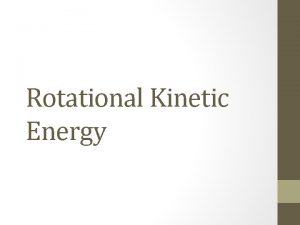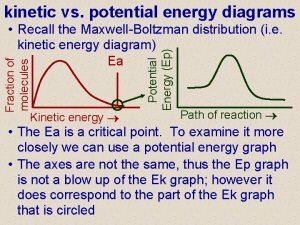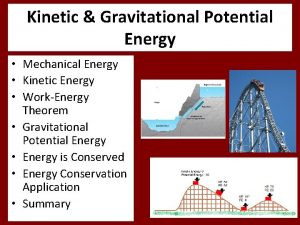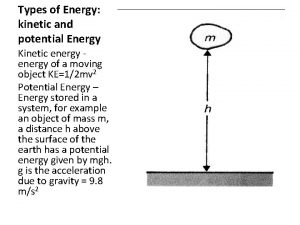Unit 2 Lesson 2 Kinetic and Potential Energy










- Slides: 10

Unit 2 Lesson 2 Kinetic and Potential Energy Copyright © Houghton Mifflin Harcourt Publishing Company

Unit 2 Lesson 2 Kinetic and Potential Energy On the Move What is kinetic energy? • Energy is the ability to cause change. There are different forms of energy. One form is kinetic energy, the energy of motion. • Every moving object has kinetic energy. The faster an object moves, the more kinetic energy it has. If two objects move at the same speed, the object that has more mass will have more kinetic energy. Copyright © Houghton Mifflin Harcourt Publishing Company

Unit 2 Lesson 2 Kinetic and Potential Energy How is the kinetic energy of an object calculated? • The kinetic energy of an object equals one-half the object’s mass (m) times the square of its volume (v). • Kinetic energy = mv 2 • When mass is expressed in kilograms (kg) and speed in meters per second (m/s), kinetic energy is expressed in joules (J). Copyright © Houghton Mifflin Harcourt Publishing Company

Unit 2 Lesson 2 Kinetic and Potential Energy It Could Change What determines the potential energy of an object? • An object that is not moving can still have energy. Potential energy is the energy an object has because of its position, condition, or chemical composition. • An object has elastic potential energy when it has been stretched or compressed. Elastic potential energy is stored in a stretched spring or a rubber band. Copyright © Houghton Mifflin Harcourt Publishing Company

Unit 2 Lesson 2 Kinetic and Potential Energy What determines the potential energy of an object? • An object has gravitational potential energy due to its position above the ground. An object held above the ground has the potential to fall. The higher the object is above the ground, the greater its gravitational potential energy. • Potential energy that depends on an object’s position is referred to as mechanical potential energy. • A substance stores chemical potential energy as a result of its chemical bonds. Some of that energy can be released during chemical reactions. Copyright © Houghton Mifflin Harcourt Publishing Company

Unit 2 Lesson 2 Kinetic and Potential Energy How is the gravitational potential energy of an object calculated? • The gravitational potential energy of an object equals its mass (m) times its height above the ground (h) times the acceleration due to Earth’s gravity (g). • Gravitational potential energy = mgh • An object’s mass is expressed in kilograms. An object’s height above the ground is expressed in meters. The acceleration due to Earth’s gravity is 9. 8 m/s 2. • Potential energy is expressed in units of joules. Copyright © Houghton Mifflin Harcourt Publishing Company

Unit 2 Lesson 2 Kinetic and Potential Energy How is the gravitational potential energy of an object calculated? • When does the bouncing ball have zero gravitational potential energy? Copyright © Houghton Mifflin Harcourt Publishing Company

Unit 2 Lesson 2 Kinetic and Potential Energy It All Adds Up! How is the mechanical energy of an object calculated? • A moving object can have both kinetic and potential energy. Mechanical energy is the energy possessed by an object due to its motion and position. • The sum of an object’s kinetic energy (KE) and mechanical potential energy (PE) is its mechanical energy (ME). • ME = KE + PE Copyright © Houghton Mifflin Harcourt Publishing Company

Unit 2 Lesson 2 Kinetic and Potential Energy How is the mechanical energy of an object calculated? • If the object’s only potential energy is gravitational potential energy, you can use the following equation to find mechanical energy. • ME = mv 2 + mgh Copyright © Houghton Mifflin Harcourt Publishing Company

Unit 2 Lesson 2 Kinetic and Potential Energy How is the mechanical energy of an object calculated? • As the basketball falls to the ground, its kinetic energy increases and its gravitational potential energy decreases. However, its mechanical energy remains constant. Copyright © Houghton Mifflin Harcourt Publishing Company
 Kinetic energy
Kinetic energy Spring potential and kinetic energy
Spring potential and kinetic energy Kinetic energy and potential energy formula
Kinetic energy and potential energy formula The change in mechanical energy
The change in mechanical energy Lesson 2 kinetic and potential energy answer key
Lesson 2 kinetic and potential energy answer key Gpe and ke equation
Gpe and ke equation Gravitational potential energy vs kinetic energy
Gravitational potential energy vs kinetic energy Kinetic potential
Kinetic potential Kinetic and potential energy
Kinetic and potential energy Graphic organizer about kinetic energy
Graphic organizer about kinetic energy Kinetic and potential energy
Kinetic and potential energy


















